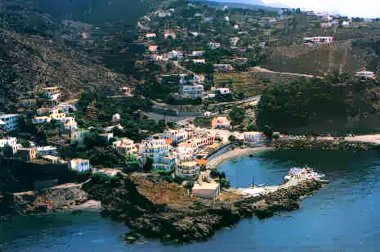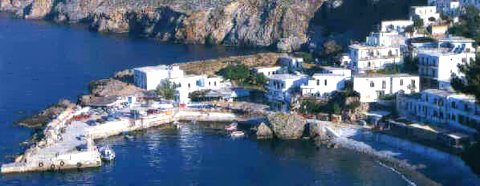The county of Sfakia (GR: Σφακιά) is one of the most mountainous in Crete and one of the most heroic, beautiful and interesting.
Sfakia are centred around the White Mountains mountain range, "Madares", as they are called in Crete with 110 peaks and the most and biggest gorges. Sfakia remain the most wild and unspoiled landscape in all Crete.
 Hora Sfakion
Hora Sfakion, (GR: Χώρα Σφακίων) the seaside capital of the county, is a coastal village located on the Southwestern coast of Crete, 70 km from the city of Hania and 150 km from Iraklion.
In its picturesque, enclosed harbor, the small boats from Agia Roumeli dock in the summer, bringing the hikers from the
Samaria Gorge. Visitors can enjoy the quiet and calm of the village , on the seaside cafes and tavernas.
The 500 inhabitants are occupied mostly with fishing and sheep and goat raising, producing excellent cheese such as Anthotyros, mizithra, etc. Recent years with the development of tourism in the region, more and more residents are engaged in tourism.
Access
Regular public transportation from
Hania is available for visiting Hora Sfakion. The bus from Hania to Hora Sfakion departs every day at 8.30 am, 11.00 am and 2.00 pm.

The road above the gorge
of Imbros
The road from Hania to Sfakia crosses the island from North to South, through the village of
Vrises. At the 33rd km of the road Hania-Rethymnon we leave the main hi way and follow a paved side road to Vrises.
From this village starts an impressive trip to the east side of the White Mountains crossing the mountainous area of Sfakia and ending to Hora Sfakion by the Lybian sea. Half way from Vrises to Hora Sfakion is the fertile plateau of Askifou, surrounded by high mountain peaks.
From Askifou plateau to Hora Sfakion is the most impressive part of the route. The road hugs the western slope of the wonderful gorge of
Imbros and the view to the gorge and to the Libyan sea is breathtaking.

History
Hora Sfakion is famous as one of the centers of the resistance against the occupying forces of both the Venetians and the Turks. The bulk of the White mountains to the north, combined with the rocky beaches on the south, helped the locals keep their freedom against all invaders. Anopolis a village near Hora Sfakion is the birth place of one of the most celebrated Cretan revolutionaries
Daskaloyiannis.
After the Battle of Crete during World War II, the locals helped the New Zealand and Australian army escape from here on the night of May 31, 1941.
Hora Sfakion prospered during the Venetian and Turkish occupation and up to the 18th century carried on a flourishing trade with its own small fleet. Near the beautiful Sfakian village of
Komitades is the Church of Panagia Thymiani where the revolution of 1821 begun. At the village of
Loutro is the ruined "chancellery" where the first revolutionary government of 1821 met. Some of the buildings in Hora Sfakion preserved today remind us of the blood-drenched and heroic history.

Some old houses, that the visitor can see here,
are typical examples of
the Sfakian architecture.
Facilities & Excursions
Hora Sfakion is an ideal base for mountainous and sea excursions to the villages and sandy beaches of southern Crete. Besides the wonderful plateau of Askifou, the village and gorge of Imbros and the traditional and historical village of Komitades, there are plenty of beaches accessible from Sfakia. The more adventurous visitor can follow the
European hiking footpath E4
which crosses Crete.
There are few hotels and rooms to rent, taverns with local food (local cheese pies "sfakianes pites" are recommended ) and bars.
Apart from the outstanding natural beauty of the indented rocky shoreline, Hora Sfakion is also worth visiting for the small Venetian fortress built there in 1526 as part of a defensive system of towers and fortresses later taken over by the Turks.